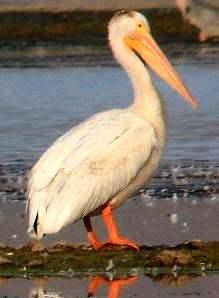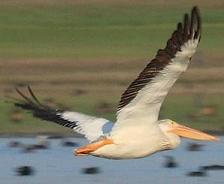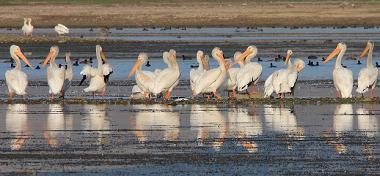White Pelican 
Identification and Pictures
(Pelecanus erythrorhynchos)
White pelicans are large water birds, 54 to 70
inches with a wing span of 8 to 9 1/2 feet. They are
white with black primaries, visible when they fly, or flap
their wings. They have orange legs, and feet, and large
flat orange-yellow bills with large throat pouches.
During breeding the adults have a horn on the top of their
bill. The sexes look similar. Juvenile birds have a
light gray color on their heads, necks, and wings. They
are very buoyant swimmers and scoop fish into their throat pouch
as they swim.

Photos by Keith
Lee. The camera I use is the Canon
EOS 40D. Visit All-birds store

They congregate in flocks which fly in lines
and broken V formations, often circling on thermal currents
high in the air.
Sound
The voice of the adult pelicans is a low
grown, but they usually make little noise. Younger birds make
whining sounds.
Preferred Habitat
White pelicans form into huge colonies, and
can be found near water sources such as lakes, marshes, and
beaches. Most populations are migratory.
Breeding and Nesting
During courtship the birds take short flights,
strut, and bow displaying their large orange bills. Once
they pair off the two birds will select a nest site usually on
open ground. They prefer to nest on isolated islands, or sandbars
to avoid predators. The nest built by both birds is a
shallow depression surrounded by dirt or vegetation. The female
will lay 2 to 3 large whitish eggs, and both birds
will incubate them for a month. After hatching both
parents will feed the young birds regurgitated food for about
30 days. They will fledge in about 10 weeks. The
parents will care for them during this time. The young birds will form into groups called crèches
or pods.
Food
White pelicans eat fish, frogs, salamanders, and aquatic invertebrates.
They fish while swimming, scooping up fish in their large
throat pouch. The birds often cooperate while fishing by
circling the fish or driving them towards shore. They
will forage at night during breeding season.
To learn about other favorite
birds click here.

|
